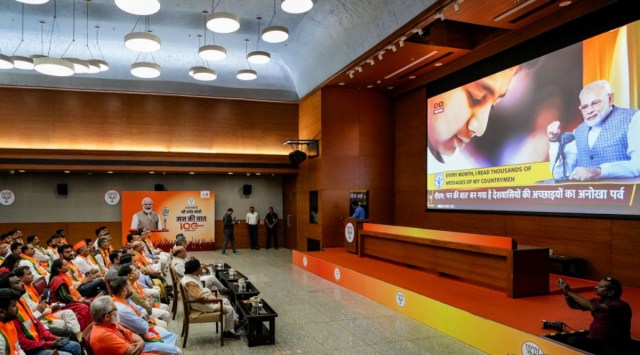
Last year, as India was celebrating 75 years of Independence, almost every household hoisted the national tricolour between August 13 and 15. Since its conception, the Har Ghar Tiranga campaign was meant to maximise public participation. Of the many steps that were taken to ensure jan bhagidari, one crucial step that ensured participation at scale was the Prime Minister speaking about Har Ghar Tiranga in his monthly radio address, ‘Mann Ki Baat’.
Last year, on July 31, in the run-up to India’s Independence Day celebrations, PM Narendra Modi used the reach and apolitical nature of Mann Ki Baat to urge every Indian to hoist a flag in their homes in the 91st edition of his monthly radio address. The result is evident.
Government missions such as Swachh Bharat, Atmanirbhar Bharat and social topics such as education of girls and women-led development have been covered by the Prime Minister several times. This has brought about immense visible behavioural change in our outlook towards hygiene, in our consumption patterns, and in the correction of the skewed sex ratio. In an early episode, PM Modi mentioned Khadi products and urged people to use them. In the last eight years, production in the Khadi sector has increased by 191 per cent while sales have increased by 332 per cent.
Why do government ministries and departments despite well-endowed publicity and marketing budgets wish for the PM to cover their initiatives in the monthly radio address? As the PM delivers his 100th Mann Ki Baat on April 30, the success of the programme is worth analysing. In my view, the most compelling explanation lies with three interrelated reasons — credible content, consistent communication, and consumer and community centricity.
A recent study on Mann Ki Baat revealed that 96 per cent of the country’s population is aware of Mann ki Baat and 100 crore people have listened to it at least once. Over 23 crore people listen to Mann Ki Baat regularly and 75 per cent of the listeners were optimistic about the programme.The apolitical nature of the programme and the positive stories and incidents therein have established an emotional connection with the audience. Further, the Prime Minister’s empathetic approach, directly addressing every citizen, has reinforced the credibility of the program. Studies suggest that nearly 71 per cent of the respondents believe Mann Ki Baat is an effective medium for the PM to communicate with Indian citizens.
One of the primary reasons for these staggering numbers is that the content infuses a sense of hope and triumph against adversities. In a world where news coverage is increasingly delving into strife and despair, the air of positivity in this programme instils a sense of proportion that a lot of good continues to take place in this country. And that this good is driven by the common person on the ground.
In today’s world, attention spans are short. Many marketing strategies suggest that long-running programmes could lead to audience attrition. However, Mann Ki Baat has bucked this trend. As head of the nation, the Prime Minister is always on the move. People are aware of his punishing schedule and his attention to detail. In spite of this, people feel that he consistently shows up at a fixed time — the last Sunday of every month — to engage with them one-on-one. PM Modi’s ability to prioritise the program and show up consistently has led people to ask themselves: “If the Prime Minister can show up every month consistently then what is stopping me from listening in?”
Mann ki Baat has also been able to break linguistic and geographical barriers in multiple ways. It is translated by All India Radio into 22 Indian languages, 29 dialects, and 11 foreign languages, apart from English. It, therefore, reaches remote areas and enables personal connections, ensuring that consistent communication is met with familiarity of one’s language.
Many of the stories in Mann Ki Baat are picked up by the Prime Minister firsthand when common citizens write to him about interesting events or accomplishments. Furthermore, the achievements that are spoken about are also usually of common people and localised events that relate to local communities. The fact that the PM provides a platform for common people to interact with him as consumers and contributors has been a key reason for the enduring popularity of the programme.
In the 98th edition of Mann Ki Baat, the Prime Minister announced the winners of the competitions organised by the Ministry of Culture — ‘Geet’ –- Patriotic Songs, ‘Lullabies’ and ‘Rangoli’. He recognised one of the winners, Sachin Narendra Avsari from Sangli, Maharashtra, for depicting the Jallianwala Bagh massacre and highlighted the bravery of Udham Singh. The fact that the PM announced the name of a normal person who won a competition created a great deal of interest. Many more would now want to unleash their creative skills.
The many themes discussed by the PM also resonate with our largest demographic — the youth. The topics covered also include issues that are not usually discussed in family settings, such as depression and mental health, and drug abuse. The Prime Minister has often spoken about exam stress, the youth’s contribution to entrepreneurship and technology advancement and in bringing laurels in the sporting domain.
The success of Mann Ki Baat may not be easy for others to replicate. Because the three ingredients mentioned are topped up with PM Modi’s own personal charisma. This century is a milestone that indeed needs to be lauded.
The writer is Union Minister of Tourism, Culture and DoNER and represents Secunderabad Constituency